Welcome to session 15… we made it to the launch 🎉
This is by no means the finish line, but it’s an important milestone, and if you are following along, make sure you take some time to give yourself a well-deserved pat on the back.
In this session, we are going to cover the latest in Amazon product launch strategies for my European launch, but this is still useful for any marketplace.
We’re going to cover a range of different launch tactics, how they work, and the benefits and downfalls of each. By the end of this session, you will be armed with all of the knowledge you need to know to decide on your own path to launch.
Jungle Slumber Updates
A quick update on some progress of Jungle Slumber:
- Photography sample has been sent to the UK based photographer
- We have a quote to air freight 300 units which are now ready to ship
- The rest of the inventory will be sent by ocean
- Keyword research and listing copy is done and ready to go
But there have been a few hiccups, namely, in getting a new Amazon Europe Seller Central account approved for this product. Sometimes, these things can happen, and they are frustrating.
What’s the deal? Well, we’re not sure if it’s a bug or if Amazon is just super backlogged due to the time of year, but they are taking their sweet time in approving this account. We have provided all of the information we can and we’re trying our utmost to get Amazon seller support to help us out. It should get approved soon, but right now we have to ride it out.

What does this mean?
Well, it means I cannot generate an FNSKU yet, or create a shipping plan. So this means that I need to either hold out before shipping any inventory… or send it using the EAN (European version of a UPC barcode) and pay Amazon to stick the FNSKU over the top when it lands at their warehouse.
Watch this space.
What can you learn from this? Well most of all, don’t hang around to set up your Seller Central account. You can do this as early as when you are doing your product research.
Here’s the slides:
Primary Product Launch Goal: Good Page Rank
Let’s set some goals, first of all. Luckily there is only one main goal, of which a few different things will feed into making it happen.
We want to get a good page rank. When you first launch your product, think of your product listing as a work in progress. It’s brand new, and it needs to gain momentum so that Amazon will rank it favorably in its rankings.
The better your rank, the higher your product will appear for your targeted keywords, and the more conversions and sales you will get from organic search.
- Improved organic traffic
- Better conversion rate
- More sales
These are the best types of sales because they don’t cost anything (compared to sales from PPC ad clicks).
However, what does cost money is the upfront investment you will need to make to get your product ranking up there with the competition.
What Goes Into Amazon Page Rank?
Here’s what factors are important:
- Sales velocity – this means you need to start generating sales right off the bat
- Sales history – it’s also important to build up your sales history, so the first few weeks of your launch are important to get the ball rolling
- Conversion rate – conversion rate is the percentage of people who visited your listing and then ‘converted’ into a customer
What about reviews?
Social proof is also really important, as this greatly helps to increase your conversion rate. And, the higher your conversion rate, the more sales you are getting, which means a great sales history. They’re all closely linked!
What can we control to positively impact sales and conversions?
Whilst you could just let your product launch once your inventory is in stock, and do nothing, it’s going to set you out down a difficult road. The first few weeks are really crucial in setting a great precedent for what is to come, which is lots of sales and profits of course. Here are the most effective things that you can directly control in order to do this:
- Increase your sales velocity with promotions
- Increase the chances of getting reviews with automated email campaigns and excellent customer service
- Increase visibility of your product whilst it’s rank is low, using Amazon PPC
There are also other things that you can do to increase sales, which involve doing some marketing outside of the Amazon platform. More on this coming up.
Launch Methods For A Better Page Rank
Let’s drill into this in a little more detail. Here’s a breakdown of the most commonly used ways you can increase sales during the launch phase:
- Use a deals site – running promotions on your new product using a deals site which has lots of bargain hunters ready to buy is an easy and cost-effective way to increase sales
- Amazon Pay Per Click – setting up Amazon PPC campaigns gets your product seen in the Amazon search results early on and when set up correctly, can help increase your sales
- Outside paid traffic – you can also run some ads on other platforms, like Google AdWords or Facebook
- Use an existing audience – if you are an influencer in your niche, and you have an email list of people interested in your niche, you can launch your product to them (can be used in conjunction with promotions)
- Build your own audience – if you don’t have your own audience lined up, you could build one
So now you understand what all of these are, let’s compare:
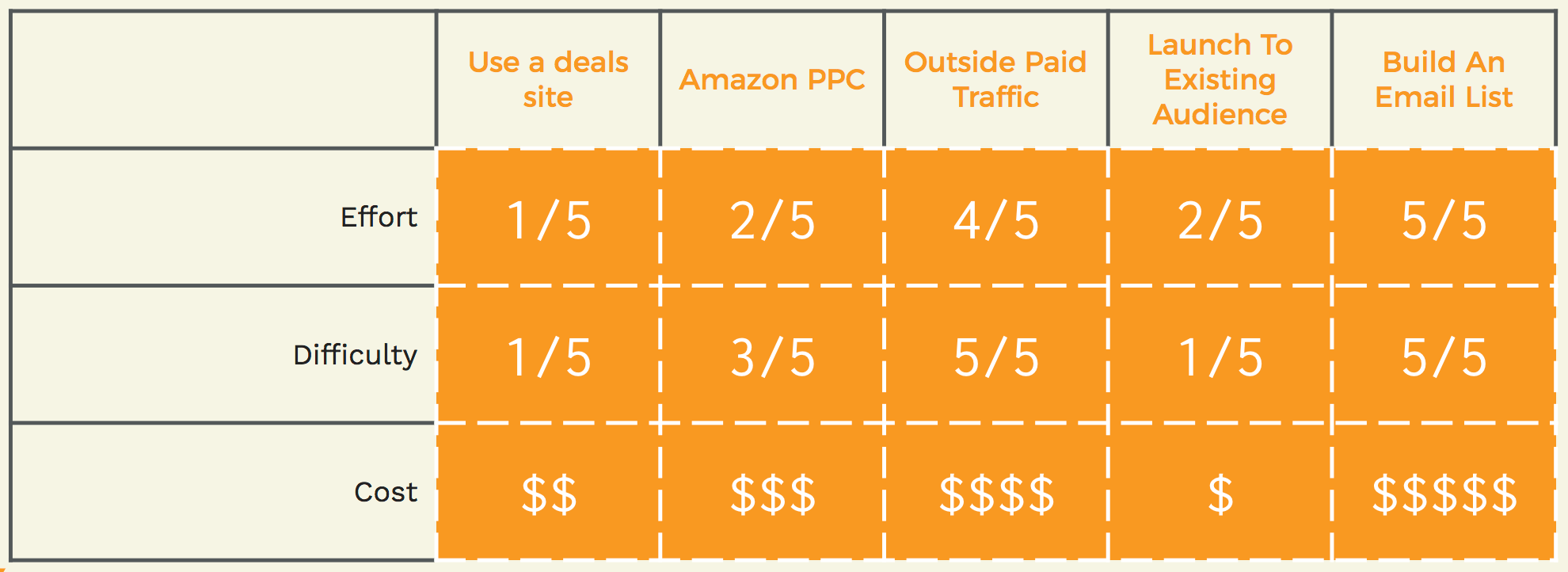
As you can see, the level of effort, difficulty, and cost varies for each. That’s not to say you can’t do all of them if you wanted to. But the advice we gave in this session is to carefully decide which tactics are most suitable for you and your business and double down on those.
Spoiler alert: For the launch of Jungle Snugs, I will be utilizing Jump Send to run promotions and send automated emails, alongside some aggressive PPC campaigns.
Pros and Cons of Each Launch Method
Before I go into detail about the launch plan for Jungle Slumber, let’s just take a deeper look into the pros and cons of each of these methods. You can also get an overview of all of this information in one place in this sessions homework:
Download the homework swipe file here
Use a deals site
✔ Set up in less than 5 minutes
✔ Almost always get sales straight away
✔ No technical experience required
✗ You need to give away the product at a deep discount – shoppers on deal sites are looking for bargains
Cost 💵
Overall, the barrier to entry and cost of this method are low, but you will need to invest by the way of selling your first units at a very deep discount. This should be seen as an upfront marketing investment for future success.
The cost to using a deals site is also relatively low (compared to some other methods). With this you can run promotions and set up automated emails to try and gather positive reviews.
Disclaimer: Jump Send is a sister product of Jungle Scout. You can use other deals sites too, but for the purposes of this case study we are going to show how I am launching Jungle Slumber with Jump Send.
Amazon PPC
✔ It’s relatively easy to set up (and this case study will show you how)
✔ You will likely set this up eventually anyway, so if you do this at launch you make a headstart
✔ The reports provide you with actual keyword data about what shoppers are searching for on Amazon, extremely useful!
✗ It’s a great method but usually not enough on it’s own, which is why I will be pairing this with promotions and automated emails.
Cost 💵
The cost of Amazon PPC varies vastly, it depends on your product, and the competition. You can expect to pay 10% – 40% for your most relevant keywords. When using this method to launch you will want to be more aggressive and bid higher. Again this is an upfront marketing investment for the future of your product. After launch, you can optimize your campaigns and tone that down, to ensure you are getting good return on investment.
Outside paid traffic
✔ If you can make this work effectively then you can leave it running post-launch, as with Amazon PPC
✗ Most sellers won’t be able to do this effectively, especially if you have no online advertising experience
Cost 💵
Again, this varies greatly. But it can quickly become an expensive mistake if you bid aggressively and do not receive any sales in return. Remember, advertising to people on Amazon is like advertising to people who are already looking for products. Though targeting is advanced on platforms like Google or Facebook, you may just end up getting clicks from people who aren’t really interested in purchasing your product.
Greg mentions in this session that he tried this tactic with other case study products, and even with an experienced PPC professional working on the campaigns, it didn’t turn out to be a fruitful investment. It likely depends also on your product niche and other variants.
So, approach with caution.
Existing Audience
✔ Inexpensive and easy to do
✗ Only relevant if you have an audience ready to go – most people won’t have this resource
Cost 💵
Other than costs of an email marketing platform (such as Mailchimp) this method is practically free. Because it relies on an existing audience you already have, so all you need to do is market your new product to them, usually via email.
If you decide to launch to an existing audience with promotions then obviously you also have the associated cost with that.
For those sellers launching products in niches they are already invested in and have an audience, this is a no-brainer!
Build Your Own Audience
✔ One you have an audience to market to, you can keep it for future launches, promotions or initiatives
✗ It takes time and money to build an audience, and it’s fairly technically challenging too (you need a website, hosting, email marketing etc.)
Cost 💵
This can be quite costly, because you need to build and host a website. Usually, you will generate a list of email addresses of people interested in your niche by running a promotion. Other ways to do this include running an influencer blog or affiliate marketing, both of which take a lot of time and dedication. It’s definitely going to cost you in time or money, or both!
The Jungle Slumber Launch
Here’s an overview of my own launch strategy for the sleeping bags!
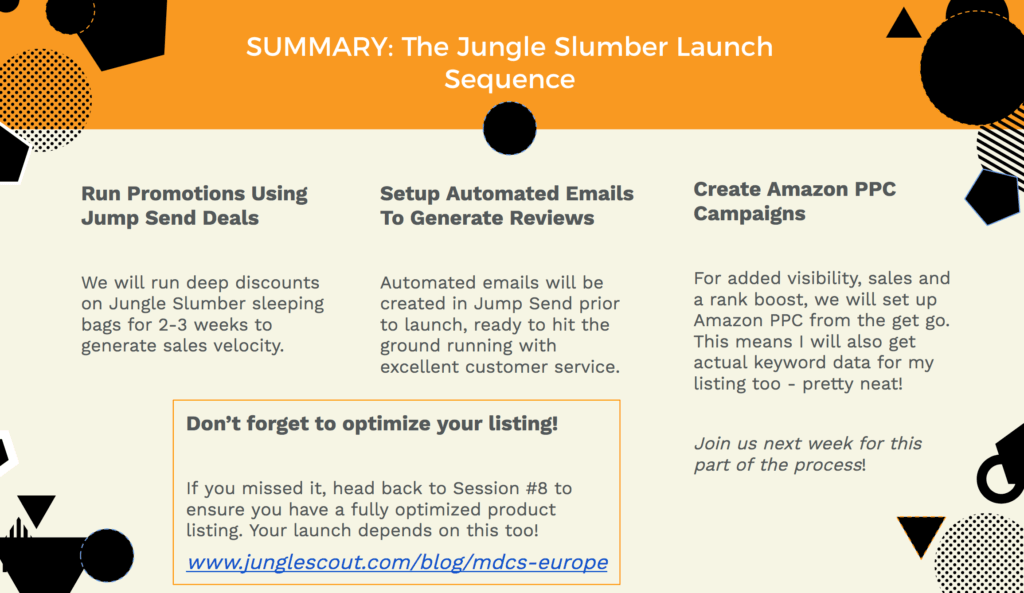
I am going with the most cost and time effective options, which is how all of the case study products have successfully been launched. Right now I am going to walk through the first two steps, and then step three, Amazon PPC will be covered in the following session.
A previously mentioned, I will be using Jump Send, which has just relaunched with full support for the UK marketplace.
Step 1: Run Promotions Using Jump Send Deals
Creating coupon codes and promotions is super easy using Jump Send. You have to first set up a promotion within Seller Central to generate your coupon codes, and then create a promotion within Jump Send and enter these coupons. The app will automatically pull in your products once you have synced your account, and the whole process only takes a few minutes.
You can watch over Greg’s shoulder on how to do this in the replay, or in this handy tutorial video.
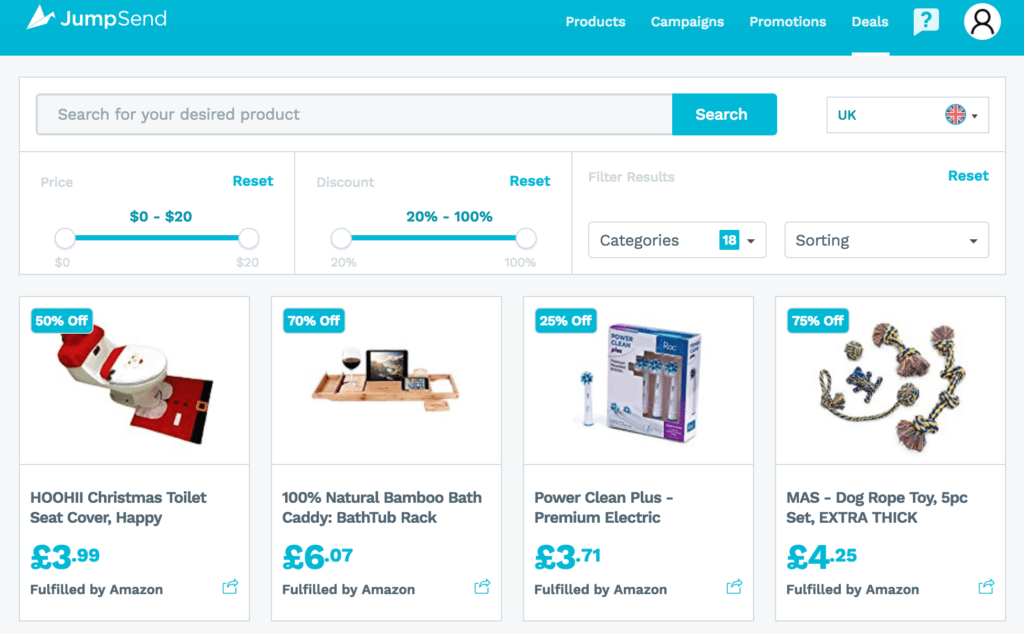
How long should I run my promotion for?
Go for a couple of weeks to begin with – you can monitor how many of your deals are being used up and make a judgment call from there. It will depend on how much inventory you ordered, but as I have 1500 units of the Jungle Slumber Sleeping bags (750 for each size), I will likely generate between 70-100 coupon codes for each size.
Jump Send allows you to set it up so that you have to manually approve each coupon request if you want to do it this way, so you always have full control.
If I find that my coupons get used up within the first week, that’s a good sign that my sales velocity and history is up. If the coupons move a little slower, then I might let this run for a little longer.
Additionally, if you start to notice organic sales coming through at full price, this is when you know it is starting to work.
How much discount should I offer?
People on deals sites like Jump Send are after deep discounts. If you set up a promotion with a 10% discount, do not be surprised if it doesn’t fly. For Jungle Slumber I will start with around 70% and see how it goes, if the coupons move slowly then I may increase that some more.
Step 2: Create Automated Email Campaigns
One of the benefits of Jump Send is that it is an all-in-one tool for both promos and emails. Sending emails to your customers is important because it provides an improved level of customer service, which is a very good way to ensure you maximize your potential of getting reviews. Plus, Jump Send also allows you to trigger an email if a customer initiates a refund, which can help you prevent negative reviews.
Again, Greg walked through the process for setting up email campaigns in the new and improved Jump Send dashboard, or you can watch this instructional guide here.
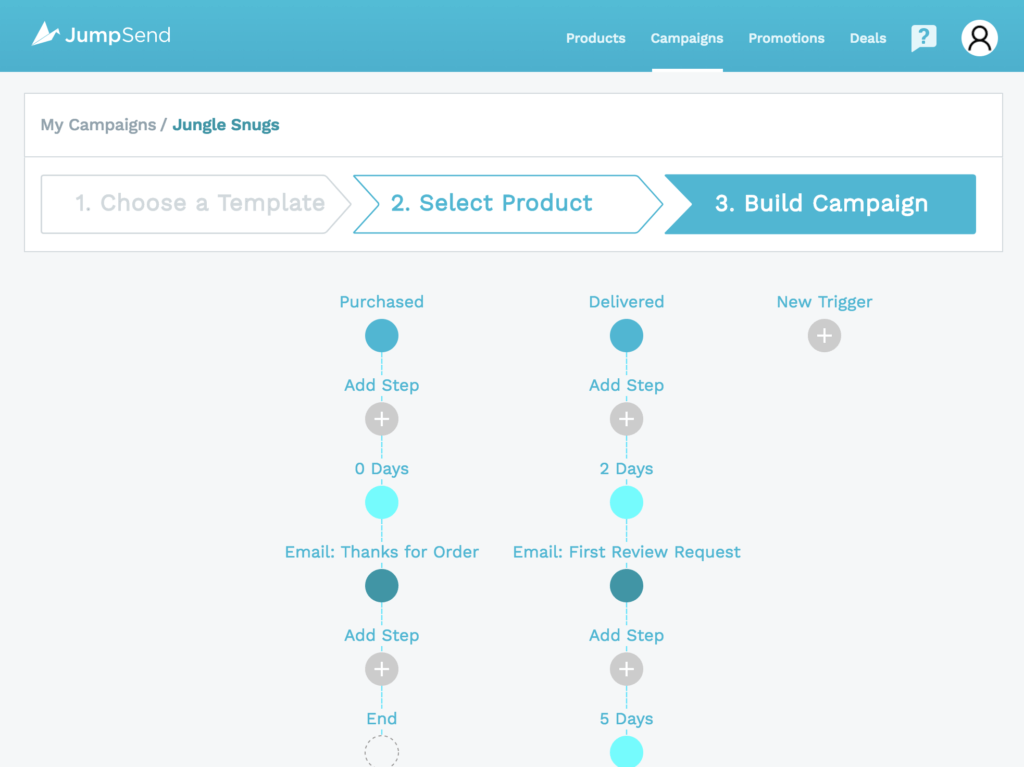
You can easily set this up using existing templates within the platform, or create your own emails from scratch, and add your own logic such as how long to wait before sending the next email.
It’s very easy to use, and if you are using our templates you can easily set this up in under 30 minutes. The email builder is in a simple WYSIWYG format, and you can add images, attachments and use smart tags to automatically insert information such as the product name or the customer’s name:
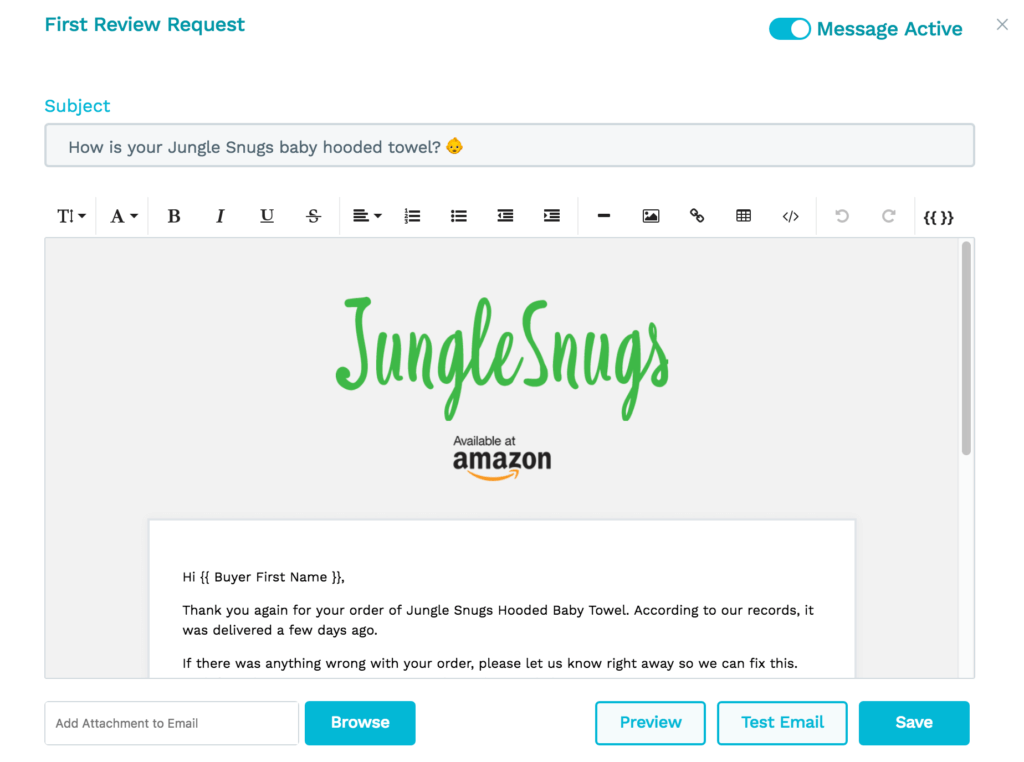
Review Hack
When it comes to getting reviews, these emails can be powerful. Sellers see an increase in CTR (that’s clicking through to the Amazon listing) from 2.2% to 3.7% (a 59% increase).
You can add this in to your emails using an autofill tag like this: {{ Product Review Link Stars }} and it will look something like this:
Using the image and rating stars increases average CTR from 2.2% to 3.7% – 59% increase
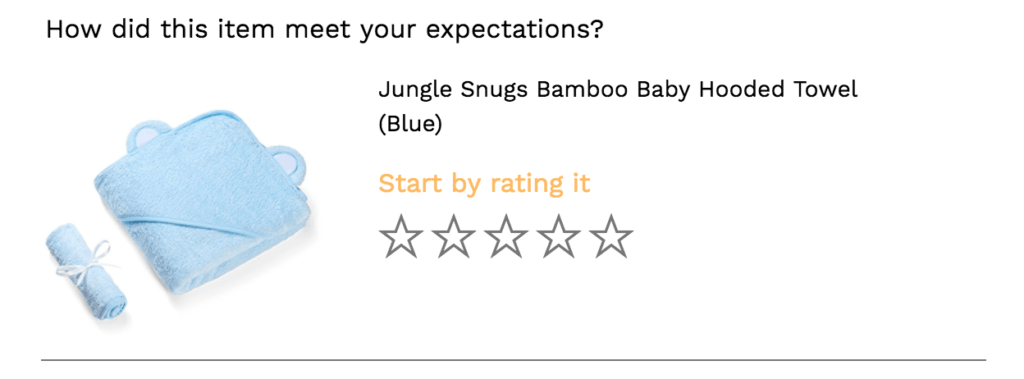
Get more information about the new features on Jump Send here.
Automated Amazon Email Do’s and Don’ts
Here’s a few top tips to guide you and ensure that your emails are effective and that are within Amazon’s TOS.
Do:
- Allow each email to have one single goal (e.g. send free content, reiterate the value of the product or ask for a review), too much information in one email confuses people and they are less likely to carry out the desired action
- Add value with product tips, tutorials, best practices, ebooks, infographics… Delight your customers, give them a good reason to leave a review
- Provide excellent customer support – let the customer know that you are there. Many Amazon purchases are done without ever knowing there is a human being running a business behind the scenes. Make sure they know you are there, that you care and that you are contactable should they have any questions.
Don’t:
- Include links to websites – this is against Amazon’s TOS. They want to keep shoppers within the Amazon ecosystem. Plus it’s probably in your best interests to focus on sending them to Amazon to leave a review anyway.
- Spam customers with emails, 2-3 is enough
- Include too many images – this risks being caught as spam. Just include one image in your email, and if you want to, a small logo at the top!
Here’s an example email sequence (remember no more than three per customer/purchase) to give you an example:
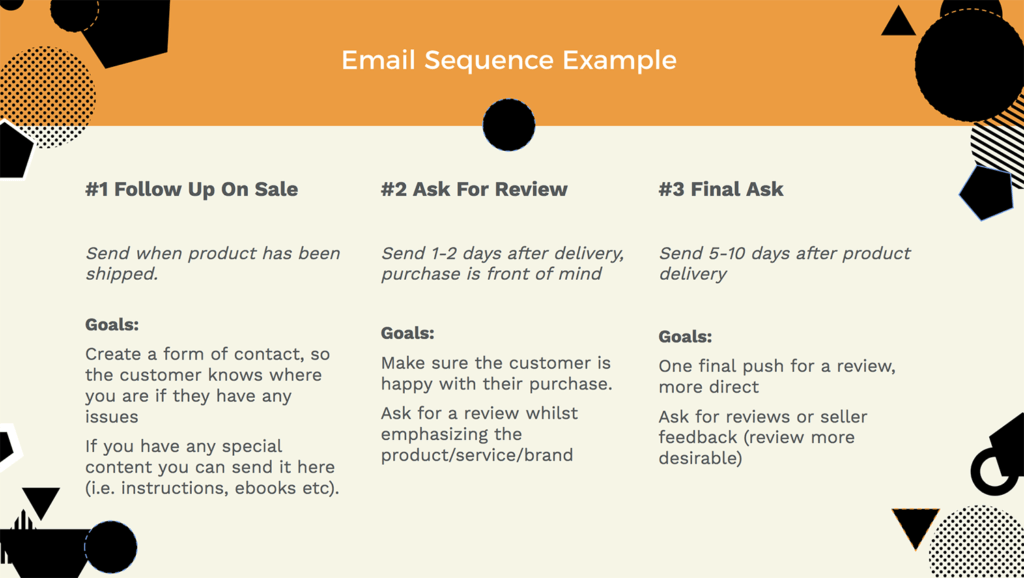
Product Inserts
One last thing, before we depart for this session, another thing that you can do to increase your chances of getting a review is to use a product insert. This is generally a printed piece of card or a fold-out with information on your product packaging. You can include information about the product, reinforce the value of the product, and ask for a review. Here’s my insert for Jungle Slumber asking very nicely for a review:
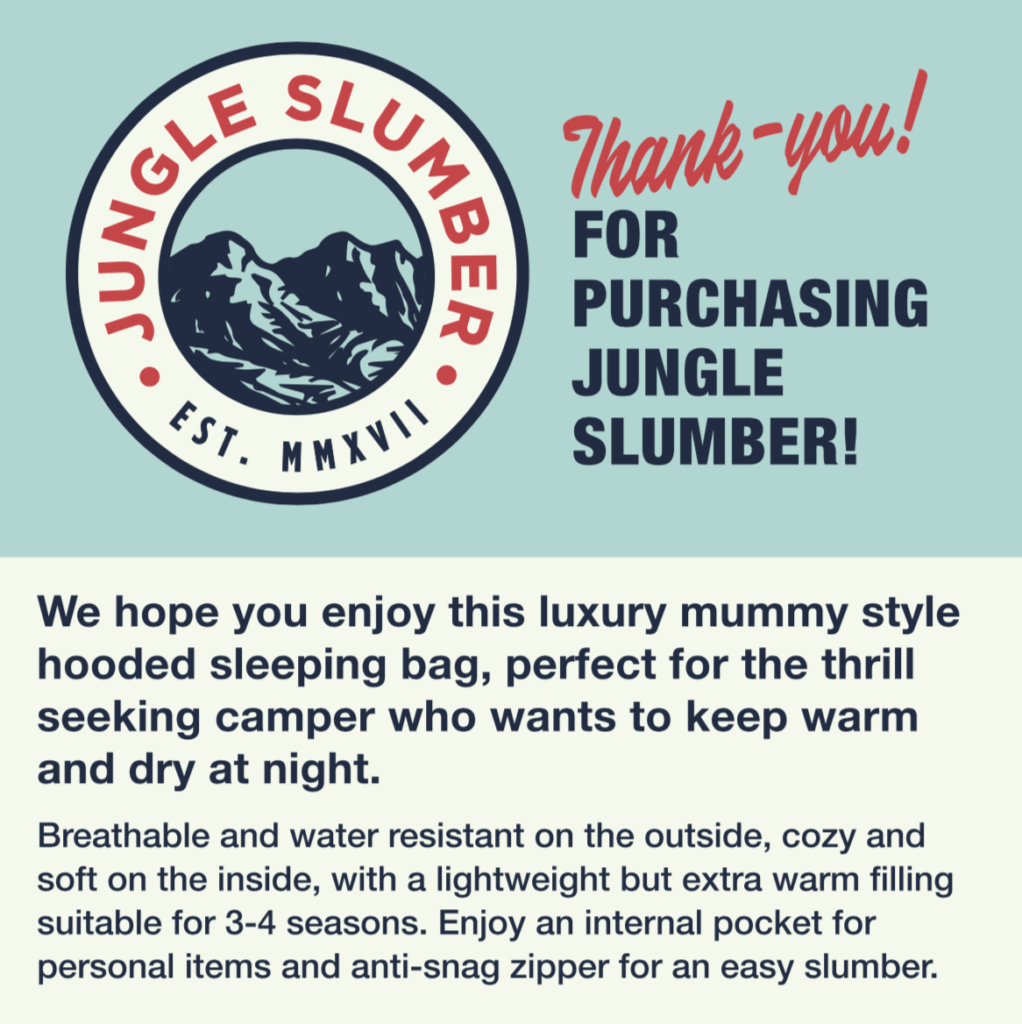
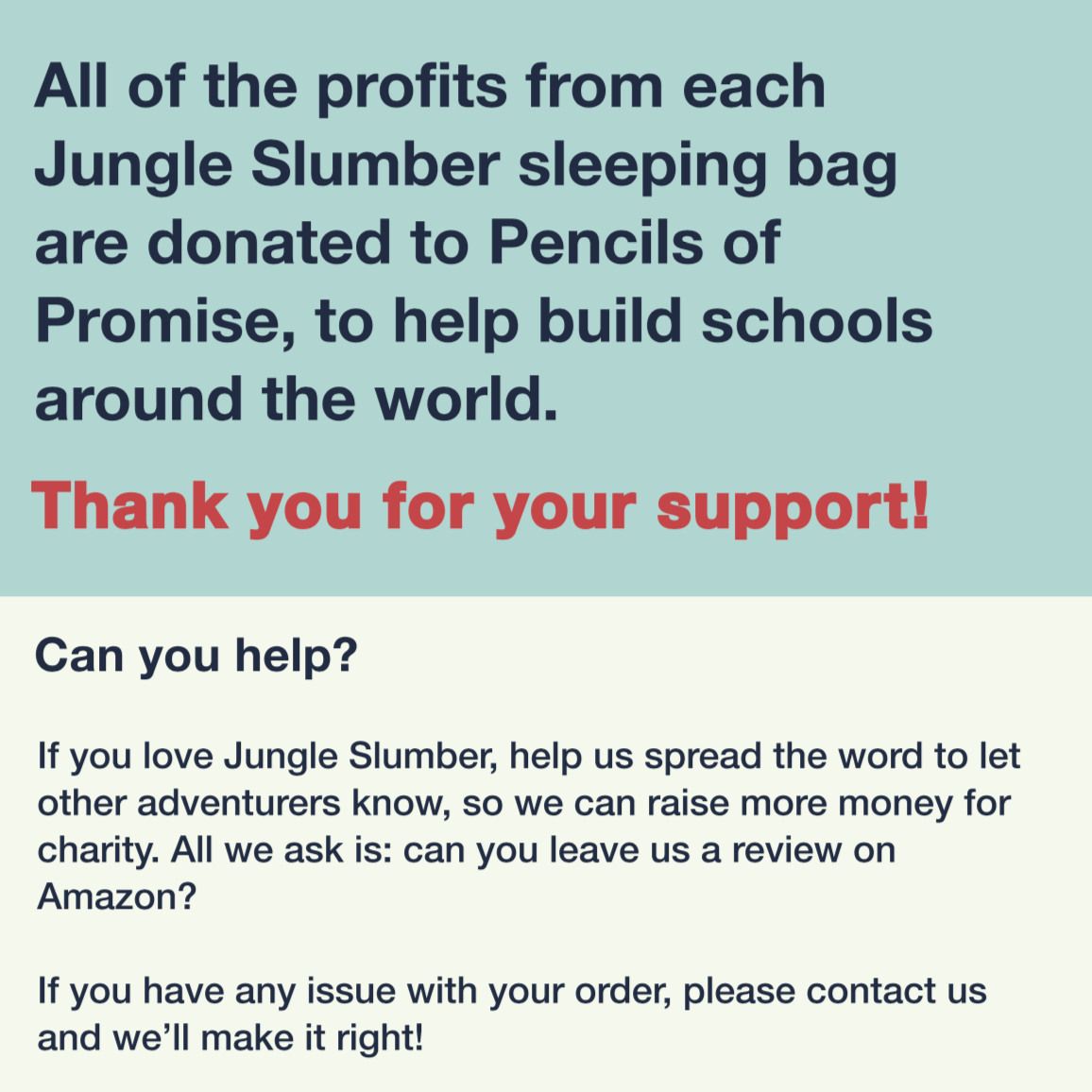
Over to you
If you are following along, now is the time to start planning and executing your very own product launch. You can use a combination of the strategies outlined in this session to suit you. Don’t forget you can grab the homework swipe sheet with all of the information comparing these launch tactics here.
As promised, the next session covers the second part of these launch strategies: Amazon PPC. Find out how to get set up and start strong with some well executed Amazon Pay-Per-Click campaigns
➡ Go to session 16!
Let us know how you get on in the comments, or if you have launched before and have some experiences to share, we’d love to hear it!
Make sure you like and subscribe over on our YouTube Channel:
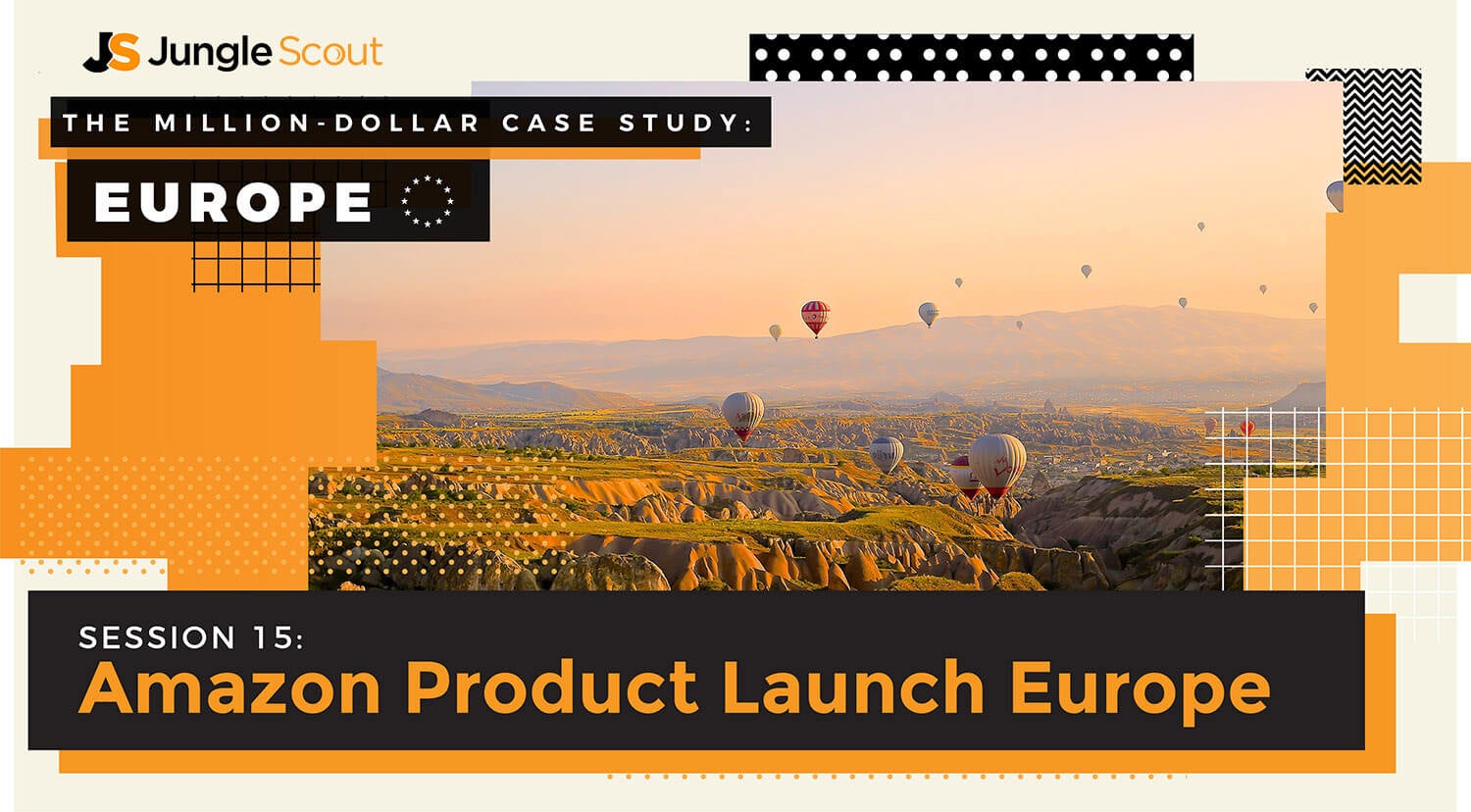
 8 Comments
8 Comments
8 comments on “The Million Dollar Case Study: Europe – Session #15: Amazon Product Launch Europe”